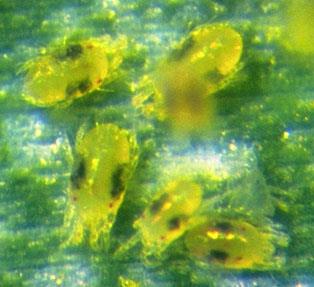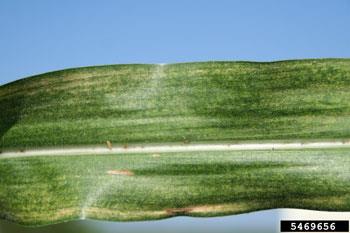
Jul 20, 2023, 2:00 PM
Two-Spotted Spider Mite
Two-spotted spider mites are a common pest that can cause significant damage to corn and soybean crops. These tiny arachnids feed on the juices of leaf cells, which can lead to discoloration, stunted growth, and reduced yields. To mitigate damage, it is important to monitor fields regularly for signs of infestation, such as yellowing leaves with fine webbing. Early detection allows for prompt treatment with insecticides or other control methods.
 Identification:
Identification:
Spider mites will appear as small moving specks on the leaves of corn and soybean plants … extremely small! They are typically cream or green in color when feeding on corn or soybeans, but they can be orange or red when conditions are unfavorable for growth, with two distinct black spots on each side of their body. The use of a handheld magnifying lens will help you better identify mite infestation.
Life Cycle:
Two-spotted spider mites typically over-winter in alfalfa fields and will infest corn and soybean fields in mid-late summer. They are carried from field to field primarily by wind. Early infestation will typically occur on the southern and western edge of fields due to prevailing winds. Once mites have infected a crop, there can be as many as 7-10 generations throughout a single cropping season and they can result in as much as 40-60% reduction in soybean yields and a reduction in corn yields of 6-48% percent for grain and up to 40% for silage.
 Control Methods:
Control Methods:
Natural Biological Control Methods:
- Natural Predators: predatory spider mite, minute pirate bug, mite destroyer beetle
- Fungal agent (fungus): Neozygites floridana
Insecticides Control Methods & Thresholds for Soybeans:
Spider mites damage soybeans by piercing the cells of plants with their mouthparts and sucking the juices from the cells. Visual spider mite damage will appear first on the top of the soybean leaf with a yellow or whitish spotting on the leaves. Recommended thresholds are based on visual damage. An insecticide application is recommended if 25% of the leaves show discoloration prior to pod set or if 10% of the leaves show discoloration once the pods have set. Once thresholds have been met, an insecticide application is recommended. Contact your local extension
office for recommendations.
Insecticides Control Methods & Thresholds for Corn:
 Two-spotted spider mites damage corn by piercing the cells of plants with their mouthparts and sucking the juices from the cells. Visual spider mite damage will appear first on the top of the corn leaf with a yellow or whitish spotting on the leaves. Leaf discoloration caused by mite feeding can be easily identified by checking the undersurface of leaves for the presence of mites, eggs, and webbing. Spider mites produce webbing and a fine network of silken webs likely will be associated with mite colonies. Colorado State University suggests, “The simple guideline is to treat if damage is visible in the lower third of the plant, and mite colonies are present in the middle third.” Once the crop has reached the hard-dough stage, no economic benefit will result from the treatment.
Two-spotted spider mites damage corn by piercing the cells of plants with their mouthparts and sucking the juices from the cells. Visual spider mite damage will appear first on the top of the corn leaf with a yellow or whitish spotting on the leaves. Leaf discoloration caused by mite feeding can be easily identified by checking the undersurface of leaves for the presence of mites, eggs, and webbing. Spider mites produce webbing and a fine network of silken webs likely will be associated with mite colonies. Colorado State University suggests, “The simple guideline is to treat if damage is visible in the lower third of the plant, and mite colonies are present in the middle third.” Once the crop has reached the hard-dough stage, no economic benefit will result from the treatment.
Why more mites when it’s dry?
The fungus neozygites floridana is an important natural enemy of the two-spotted spider mite, but it needs higher humidity and temperatures of 85°F or less to thrive. The fungus does not thrive under hot and dry conditions. This is why scouting for spider mites in field crops is encouraged with prolonged dry conditions.
Summary:
Two-spotted spider mites can significantly reduce yields if not managed properly. Fortunately, there are several control methods available for growers to use. By implementing effective control measures, growers can protect their crops from two-spotted spider mites and achieve maximum yields. However, early detection is key to preserving plant health, so be sure to scout fields regularly, particularly under hot and dry conditions when two-spotted spider mites tend to thrive.
Resources:
- crops.extension.iastate.edu/encyclopedia/twospotted-spider-mites
- cropwatch.unl.edu/2016/managing-spider-mites-corn-and-soybean
Photo Credits: Photos courtesy of Daren Mueller, Iowa State University, Bugwood.org, and University of Nebraska Cropwatch.

